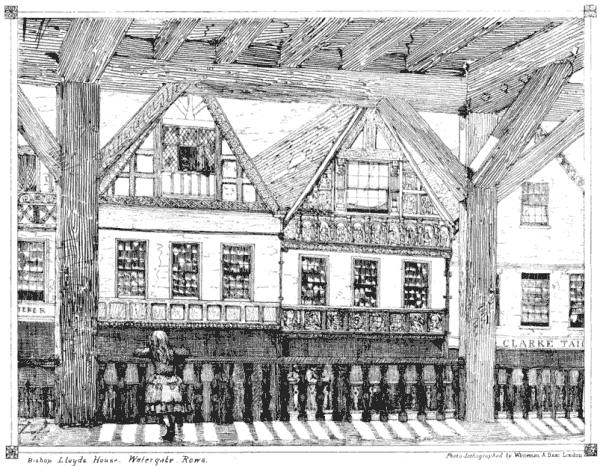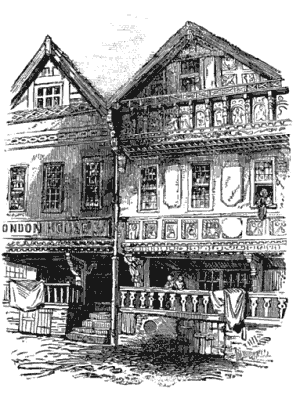
[from Chester as it was London: 1872 J.S. Howson and A. Rimmer]

CAREFUL notice of the domestic architecture of an old city is quite essential in any attempt to give a correct impression of what that city was. The mere consideration of Churches, even if there be among them a Cathedral with considerable variety of detail, leaves the matter very imperfect. In Chester, besides several other ancient houses of great interest, are two marked out for special attention. The previous pages contain some general remarks on their architecture, and on their connection with the social life of past times. Here we may with advantage trace out the ecclesiastical associations connected with one of these houses.
Of Bishop Lloyd we know very little. His epitaph shows that he was a Welshman. He was educated at the Cathedral Grammar School in Chester. He seems afterwards to have been Divinity Lecturer in this Cathedral ; and before he returned to Chester as its Bishop, he held the See of Sodar[sic Sodor] and Man. No biographical facts are positively known, which connect him with this house : but it has always been called by his name ; and the date, the mitre, and the arms of the See of Man, which are conspicuous on its front, seem to show conclusively that he either built this house or at one time resided in it. The sculptured representations of religious subjects which we see here are very curious and grotesque. The latin inscription has never been satisfactorily explained.
Lloyd died in 1615 ; and now, taking this house as our point of departure, we may glance in succession at all the Bishops who held this See during the varied religious events of the seventeenth century, Moreton, who succeeded him, is more especially connected with the See of Durham, to which he was translated. Next to him came Bridgeman, whose life was spent in the very midst of the ecclesiastical storm. After being deprived of his office by Cromwell, he died in obscurity at Morton, in Shropshire. The Lady Chapel of the Cathedral contains a memorial of him in the fine woodwork of his pulpit, which formerly stood in the Choir : and, now that crowded congregations meet every Sunday evening in the Nave, it is interesting to recall what we are told of this good Bishop, that he wished Sermons to be preached in that large space, but that the proposal was not then acceptable to the citizens. At the accession of Charles II the Bishop consecrated for the See of Chester was Brian Walton, whose Polyglott makes him for ever famous in the annals of Biblical learning. He died in London and was buried in old St. Paul’s. Ferne, who was appointed to succeed him, lived only a few weeks after his consecration. His grave is in Westminster Abbey. The epitath near the western door of Chester Cathedral, which commemorates the next Bishop, George Hall and was written by himself is well worthy of careful attention. He was the son of the famous Joseph Hall, Bishop of Norwich, and describes himself as deserving of notice only because he was the son, " or rather the shadow," of his father ; and he adds, using the emblem of a candle, which is sculptured on the stone, that he is thankful to be " burnt out " in the service of the Church, if only he may " give light." The two next Bishops were men of the very highest distinction. Wilkins was one of the founders of the Royal Society : his name occurs frequently in Evelyn’s " Memoirs ;" and, after what has been written above, it is amusing to add that he married Cromwell’s sister. Of Pearson, the author of the " Exposition of the Creed," and the greatest English Theologian of his day, it is enough to say, with Burnett, that " his very dross was gold." Of Cartwright, who was originally a Presbyterian, it is stated that he ultimately " went all lengths " with James II. He was the Bishop here during that visit of this king, which is mentioned in the notice of St. Peter’s Church ; and he accompanied him to Dublin and died there. Stratford who seems to have been a man of thorough worth, piety, and consistency, closes a list, which presents us with what may truly be called an epitome of the church history of the century.
J.S. H.

|
see also Stanley House |
||
|
|
||
|
Any comments, errors or omissions
gratefully received The
Editor |
||